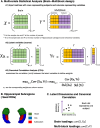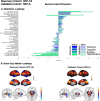Discovery, Replicability, and Generalizability of a Left Anterior Hippocampus' Morphological Network Linked to Self-Regulation
- PMID: 39705057
- PMCID: PMC11661003
- DOI: 10.1002/hbm.70099
Discovery, Replicability, and Generalizability of a Left Anterior Hippocampus' Morphological Network Linked to Self-Regulation
Abstract
The human hippocampus is a key region in cognitive and emotional processing, but also a vulnerable and plastic region. Accordingly, there is a great interest in understanding how variability in the hippocampus' structure relates to variability in behavior in healthy and clinical populations. In this study, we aimed to link interindividual variability in subregional hippocampal networks (i.e., the brain grey matter networks of hippocampal subregions) to variability in behavioral phenotype. To do so, we used a multiblock multivariate approach mapping the association between grey matter volume in hippocampal subregions, grey matter volume in the whole brain regions, and behavioral variables in healthy adults. To ensure the robustness and generalizability of the findings, we implemented a cross-cohort discovery and validation framework. This framework utilized two independent cohorts: the Human Connectome Project Young Adult (HCP-YA) cohort and the Human Connectome Project Aging (HCP-A) cohort, enabling us to assess the replicability and generalizability of hippocampal-brain-behavior phenotypes across different age groups in the population. Our results highlighted a left anterior hippocampal morphological network including the left amygdala and the posterior midline structures whose expression relates to higher self-regulation, life satisfaction, and better performance at standard neuropsychological tests. The cross-cohort generalizability of the hippocampus-brain-behavior mapping demonstrates its relevance beyond a specific population sample. Our previous work in developmental populations showed that the hippocampus' head co-maturates with most of the brain during childhood. The current data-driven study further suggests that grey matter volume in the left hippocampal head network would be particularly relevant for self-regulation abilities in adults that influence a range of life outcomes. Future studies should thus investigate the factors influencing the development of this morphological network across childhood, as well as its relationship to neurocognitive phenotypes in various brain diseases.
Keywords: CCA; brain–behavior relationships; generalizability; hippocampus' organization; machine learning; replicability.
© 2024 The Author(s). Human Brain Mapping published by Wiley Periodicals LLC.
Conflict of interest statement
The authors declare no conflicts of interest.
Figures





Similar articles
-
Parcellation of the human hippocampus based on gray matter volume covariance: Replicable results on healthy young adults.Hum Brain Mapp. 2019 Sep;40(13):3738-3752. doi: 10.1002/hbm.24628. Epub 2019 May 22. Hum Brain Mapp. 2019. PMID: 31115118 Free PMC article.
-
Characterizing the gradients of structural covariance in the human hippocampus.Neuroimage. 2020 Sep;218:116972. doi: 10.1016/j.neuroimage.2020.116972. Epub 2020 May 23. Neuroimage. 2020. PMID: 32454206
-
Dissociable Disruptions in Thalamic and Hippocampal Resting-State Functional Connectivity in Youth with 22q11.2 Deletions.J Neurosci. 2019 Feb 13;39(7):1301-1319. doi: 10.1523/JNEUROSCI.3470-17.2018. Epub 2018 Nov 26. J Neurosci. 2019. PMID: 30478034 Free PMC article.
-
Region-specific sex differences in the hippocampus.Neuroimage. 2020 Jul 15;215:116781. doi: 10.1016/j.neuroimage.2020.116781. Epub 2020 Apr 9. Neuroimage. 2020. PMID: 32278894
-
Are the dorsal and ventral hippocampus functionally distinct structures?Neuron. 2010 Jan 14;65(1):7-19. doi: 10.1016/j.neuron.2009.11.031. Neuron. 2010. PMID: 20152109 Free PMC article. Review.
References
-
- Barnes, J. , Scahill R. I., Schott J. M., Frost C., Rossor M. N., and Fox N. C.. 2005. “Does Alzheimer's Disease Affect Hippocampal Asymmetry? Evidence From a Cross‐Sectional and Longitudinal Volumetric MRI Study.” Dementia and Geriatric Cognitive Disorders 19, no. 5–6: 338–344. - PubMed
-
- Besteher, B. , Gaser C., and Nenadić I.. 2020. “Brain Structure and Subclinical Symptoms: A Dimensional Perspective of Psychopathology in the Depression and Anxiety Spectrum.” Neuropsychobiology 79, no. 4–5: 270–283. - PubMed
-
- Caplan, J. B. , McIntosh A. R., and De Rosa E.. 2007. “Two Distinct Functional Networks for Successful Resolution of Proactive Interference.” Cerebral Cortex 17, no. 7: 1650–1663. - PubMed
MeSH terms
Grants and funding
LinkOut - more resources
Full Text Sources
Medical
Miscellaneous

